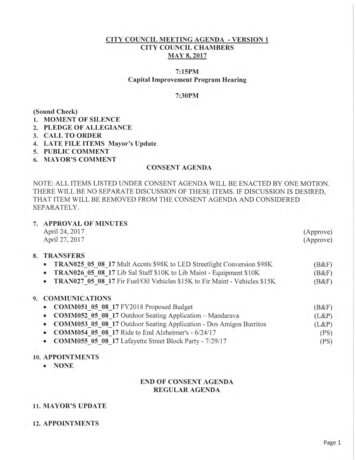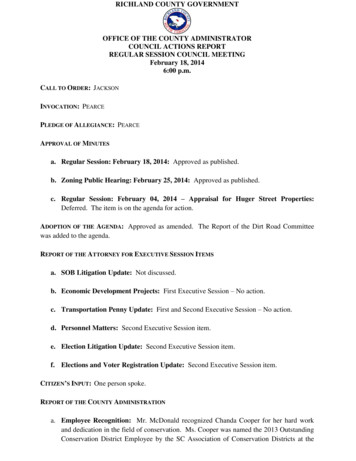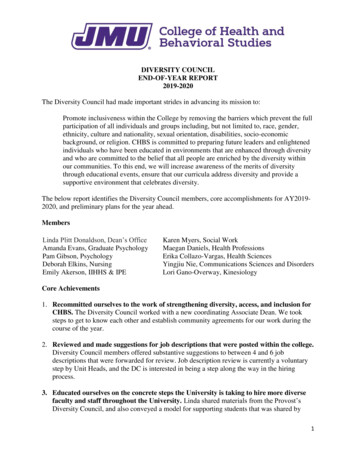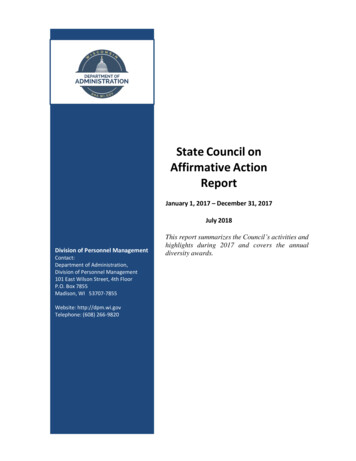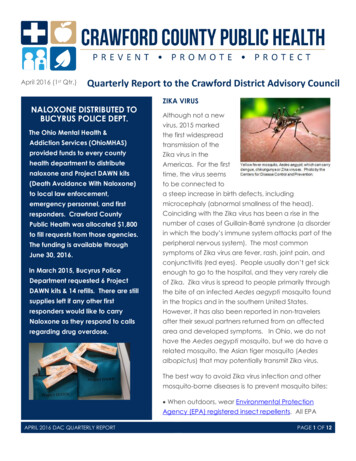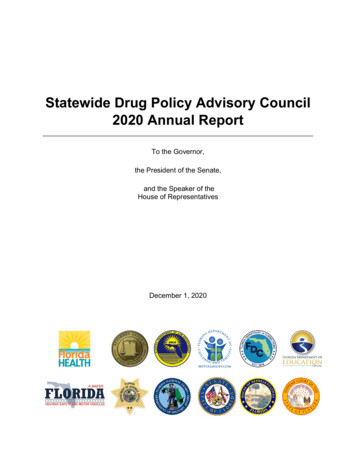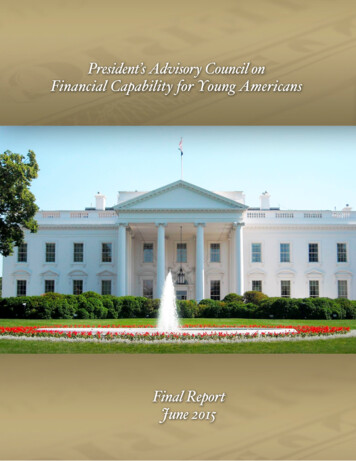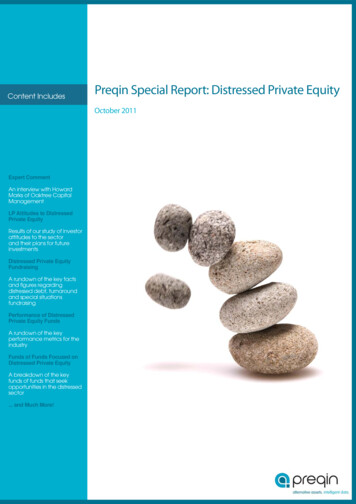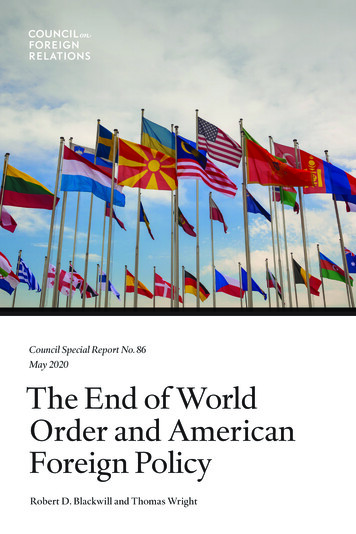
Transcription
Council Special Report No. 86May 2020The End of WorldOrder and AmericanForeign PolicyRobert D. Blackwill and Thomas Wright
Council Special Report No. 86May 2020The End ofWorld Orderand AmericanForeign PolicyRobert D. Blackwill and Thomas Wright
The Council on Foreign Relations (CFR) is an independent, nonpartisan membership organization,think tank, and publisher dedicated to being a resource for its members, government officials, businessexecutives, journalists, educators and students, civic and religious leaders, and other interestedcitizens in order to help them better understand the world and the foreign policy choices facing theUnited States and other countries. Founded in 1921, CFR carries out its mission by maintaining adiverse membership, with special programs to promote interest and develop expertise in the nextgeneration of foreign policy leaders; convening meetings at its headquarters in New York and inWashington, DC, and other cities where senior government officials, members of Congress, globalleaders, and prominent thinkers come together with Council members to discuss and debate majorinternational issues; supporting a Studies Program that fosters independent research, enabling CFRscholars to produce articles, reports, and books and hold roundtables that analyze foreign policyissues and make concrete policy recommendations; publishing Foreign Affairs, the preeminent journalon international affairs and U.S. foreign policy; sponsoring Independent Task Forces that producereports with both findings and policy prescriptions on the most important foreign policy topics; andproviding up-to-date information and analysis about world events and American foreign policy on itswebsite, CFR.org.The Council on Foreign Relations takes no institutional positions on policy issues and hasno affiliation with the U.S. government. All views expressed in its publications and on itswebsite are the sole responsibility of the author or authors.Council Special Reports (CSRs) are concise policy briefs, produced to provide a rapid response to adeveloping crisis or contribute to the public’s understanding of current policy dilemmas. CSRs arewritten by individual authors—who may be CFR fellows or acknowledged experts from outside theinstitution—in consultation with an advisory committee, and are intended to take sixty days frominception to publication. The committee serves as a sounding board and provides feedback on a draftreport. It usually meets twice—once before a draft is written and once again when there is a draft forreview; however, advisory committee members, unlike Task Force members, are not asked to sign offon the report or to otherwise endorse it. Once published, CSRs are posted on CFR.org.For further information about CFR or this Special Report, please write to the Council on ForeignRelations, 58 East 68th Street, New York, NY 10065, or call the Communications office at212.434.9888. Visit our website, CFR.org.Copyright 2020 by the Council on Foreign Relations , Inc.All rights reserved.Printed in the United States of America.This report may not be reproduced in whole or in part, in any form beyond the reproduction permittedby Sections 107 and 108 of the U.S. Copyright Law Act (17 U.S.C. Sections 107 and 108) and excerptsby reviewers for the public press, without express written permission from the Council on ForeignRelations.To submit a letter in response to a Council Special Report for publication on our website, CFR.org,you may send an email to publications@cfr.org. Alternatively, letters may be mailed to us at:Publications Department, Council on Foreign Relations, 58 East 68th Street, New York, NY 10065.Letters should include the writer’s name, postal address, and daytime phone number. Letters may beedited for length and clarity, and may be published online. Please do not send attachments. All lettersbecome the property of the Council on Foreign Relations and will not be returned. We regret that,owing to the volume of correspondence, we cannot respond to every letter.This report is printed on paper that is FSC Chain-of-Custody Certified by a printer who is certifiedby BM TRADA North America Inc.
CONTENTSiv Forewordvii Acknowledgments148131524IntroductionWorld Order Before COVID-19The End of World OrderThe Road ForwardRecommendationsConclusion26 Endnotes33 About the AuthorContentsiii
FOREWORDWorld order is a fundamental concept of international relations. At itscore, world order is a description and a measure of the world’s condition at a particular moment or over a specified period of time. It tendsto reflect the degree to which there are widely accepted rules as to howinternational relations ought to be carried out and the degree to whichthere is a balance of power to buttress those rules so that those whodisagree with them are not tempted to violate them or are likely to fail ifin fact they do. Any measure of order necessarily includes elements ofboth order and disorder and the balance between them.Until recently, articles and books explicitly examining world orderhave been few in number, principally because for the past seventy-fiveyears world order was clearly defined. During the Cold War, the orderwas bipolar, split between American- and Soviet-led camps. A balanceof power, bolstered by nuclear deterrence, kept the central peace, andshared understandings (mostly implicit) of the legitimate aims of foreign policy circumscribed the behavior of both superpowers. Following the Cold War’s end and the Soviet Union’s collapse some threedecades ago, a U.S.-led world order prevailed, underpinned by American absolute economic and military strengths and relative advantageover others. Now, however, against the backdrop of a retrenchingUnited States, a rising China, a resentful and assertive Russia, a nuclearNorth Korea, and an ambitious Iran, not to mention a number of serious global challenges, much of what had been assumed can no longer betaken for granted. Both the balance of power and the consensus at theheart of world orders has faded.At this moment of uncertainty and potential transition, acceleratedby the ongoing COVID-19 pandemic, Robert D. Blackwill, the HenryA. Kissinger senior fellow for U.S. foreign policy here at the CouncilivForeword
on Foreign Relations, and Thomas Wright, the director of the Centeron the United States and Europe and a senior fellow at the BrookingsInstitution, present this new Council Special Report, The End of WorldOrder and American Foreign Policy. The report is both analytical andprescriptive. As regards the former, the authors note that along withU.S.-Soviet competition and the Cold War, the COVID-19 pandemicrepresents the most serious challenge to the U.S.-led internationalorder. They call this “a moment of radical international uncertainty”that “occurs at a troubling time geopolitically, including the withdrawalof the United States from global leadership.”Blackwill and Wright present the case that the old order has givenway to multiple orders, which in effect is disorder. “The world has movedaway from a Kissingerian standard of world order, in which nationswork within the same set of constraints and aspire to meet the same setof rules, toward a model where many countries choose their own pathsto order, without much reference to the views of others.” More specifically, the two argue the pandemic has undermined order by straininggovernments, dividing societies, exacerbating societal inequalities,heightening tensions between the United States and China, and demonstrating the vast gap between global problems and the world’s ability toaddress them through existing international institutions.The authors go on to provide recommendations that would allowthe United States to “preserve its national interests and its own notionof international order.” First, they argue that American foreign policymust begin at home, and the United States needs to focus on improving domestic governance and its economic competitiveness so that thecountry regains the will and the capacity to play an active role abroad.They then call for the United States to invest in its relations withForewordv
Canada and Mexico, develop a more collaborative approach to allies,increase partnership with Europe, upgrade relations with India, investin international institutions, seek a way to resume engagement withRussia, and focus less on the Middle East and more on Asia. More thananything else, the approach to order advocated here places managinginevitable and growing competition with China at the heart of American diplomacy and its search for order in the world.I expect what is written in the report about order may be too narrowor too traditional for some readers. This is to be expected. Such debatereflects the reality that this is a moment of real change in the world, coupled with intellectual foment about how to understand it and what todo about it. This Council on Foreign Relations Special Report makesan important, rigorous, and considered contribution to this emergingand critical debate.Richard N. HaassPresidentCouncil on Foreign RelationsMay 2020viForeword
ACKNOWLEDGMENTSThis Council Special Report greatly benefited from the dozens of specific suggestions and valuable improvements by Hal Brands, TarunChhabra, Francis J. Gavin, Lyndsay Howard, William Inboden, BruceJones, Shankar Menon, Lord Charles Powell, Ed Rogers, Dennis Ross,Gary Roughead, Shyam Saran, Jake Sullivan, Stephen M. Walt, PhilipZelikow, and Robert Zoellick. We took many of their suggested fixesbut, as they will see, not all. We also thank the speakers and membersof the CFR World Order Study Group for their insights during oursessions over the past eight months. To pay attention to smart peoplealways makes one smarter, or, as George Shultz once observed, “Listening is an underrated way of acquiring knowledge.” We also thankCouncil on Foreign Relations (CFR) President Richard N. Haass forhis review and comments. We appreciate the work of Patricia Dorff andthe CFR Publications team for their editorial contributions. Our special thanks to Daniel Clay for his extensive work on this report.The analysis and conclusions herein are the authors’ responsibilityalone.Robert D. Blackwill and Thomas WrightAcknowledgmentsvii
INTRODUCTIONAlong with U.S.-Soviet competition during the Cold War, COVID19 is one of the two greatest tests of the U.S.-led international ordersince its founding over seven decades ago.1 Nothing else since that timeapproaches the societal, political, and economic effects of the virus onpopulations around the world. Not the dozens of violent conflicts thaterupted in the international system since 1945. Not the many regionaland global economic downturns over the years that reduced the qualityof life of ordinary citizens. Not the international effects of the “Timeof Troubles” in the United States, from the assassinations, urban riots,and mass demonstrations of 1968, to the presidential resignation in1974. Not even the two million people who died of smallpox in 1967 in afar less connected world.At the time of writing, millions are infected globally with millionsmore likely to come, and hundreds of thousands are dead.2 Entire populations remain indoors. The International Monetary Fund (IMF)quarterly report World Economic Outlook labeled the crisis the GreatLockdown and estimated a reduction in global growth of 3 percent,which makes it the most severe recession since the Great Depressionand far worse than the 2008 global financial crisis.3 Accumulatedlosses in 2020 and 2021 could reach 9 trillion, which is more than theGerman and Japanese economies combined. During this crisis, twobillion people could fall into abject poverty, half of all jobs in Africacould be lost, oil exports in the Middle East could drop by 250 billion, more than ninety countries could receive aid from the IMF, thenumber of unemployed people in the United States is over 38.6 million,and the European Union (EU) forecasts the deepest economic recession in its history with EU economies to shrink by 7.4 percent this year.4Even as the world goes back to work, any reopening will be partial,Introduction1
with large sectors of society in many nations staying closed. There isa near-consensus among health experts that the crisis will last in oneform or another for well over a year, and perhaps longer. The economicand societal consequences will prevail much longer. There will be noV-shaped economic rebound.5This is a moment of radical international uncertainty. Despite manycommentaries to the contrary, it is difficult to predict what the longterm impact of the COVID-19 crisis will be on the quest for worldorder.6 The last major pandemic, in 1918–19, is not generally judged tohave had a major effect on the 1920s and 1930s, but that is likely becauseit happened in a world already fragmented by World War I.7 By contrast,although this crisis occurs at a troubling time geopolitically, includingthe withdrawal of the United States from global leadership, until thepandemic it was a period of interdependence and prosperity for manycountries. This plague puts immense strain on individual governments,divides societies, and exacerbates societal inequalities. It encouragesleaders to act unilaterally and nationally, rather than in concert. Itdemonstrates the weaknesses of most international organizations. Itexacerbates tensions between the United States and China.8 It promptsthe United States’ adversaries to try to take advantage of Washington’stardy and confused reaction to the epidemic.The crisis poses enveloping international questions. When willthe global economy recover? Can Washington and Beijing avoid permanent confrontation with potential catastrophic consequences?9Will China advance its national interests at the expense of the UnitedStates? Will the U.S. alliance system continue to erode? Will the crisisempower or undermine nationalists and populists? Will the EuropeanUnion undertake sufficient economic reform that it can retain the allegiance of countries such as Italy by showing that it will be there for all ofits member states in a crisis? What will happen in the developing world,where governments have limited health-care capacity and minimalability to enforce social distancing? Will medical shortcomings triggermass migration? Will mass digital surveillance become more attractiveif it offers an alternative to economic shutdown? These matters are ofenormous import, but they are impossible to answer with any confidence at this stage.The objective of this report is not to predict the long-term consequences of the present crisis (as the American philosopher Yogi Berrastressed, “It’s tough to make predictions, especially about the future”).Rather, it is to place this plague in global context. After the Cold War,many observers believed the world’s largest powers were converging on2The End of World Order and American Foreign Policy
a single model of international order—a globalized version of the orderthe United States had led since the late 1940s. Before Washington’s twolong wars in the greater Middle East, the rise of China, and the revivalof Russia, the 1990s in general was a rare historical decade of a mostlystable, mostly harmonious, and mostly peaceful world order—one thatwas imperfect and incomplete, but still stood apart from the normalanarchic state of international politics.10This world order period weakened after 9/11 and ended over thepast decade, driven by a combination of great power ambition, American withdrawal, and transformational changes that left many nationsunmoored from old certainties, “no longer at ease here, in the old dispensation.”11 This report portrays the international situation before thecoronavirus struck, posits its current effects on world order, and prescribes what the United States should do about it.Introduction3
WORLD ORDERBEFORE COVID-19To understand the world today, one must first understand the world thatcame before. We began this project in the fall of 2019 precisely becausethe world order seemed so troubled. Indeed, for at least six years, sinceRussia’s annexation of Crimea, analysts wrote about the collapse ofinternational order, a tendency that was reinforced by the proliferationof failed states and refugee crises in the Middle East, Brexit, the electionof President Donald J. Trump and other populists, the rise of Chinesepower and consequent increased rivalry between Washington and Beijing, and a worsening climate.12 As Robert Kagan put it, the jungle wasgrowing back.13And yet, that the international system is beset by problems and thatthose difficulties are getting worse is not in itself proof that world orderis falling apart. Until COVID-19, global economic growth was strongwhile poverty continued to decline. The major powers were not on thebrink of conflict. With the exception of the Middle East, most of theworld’s regions were stable. Significant technological breakthroughsimproved the lives of billions.14 So a more fundamental question shouldbe asked: How should world order be defined?It is helpful to make an initial distinction between internationalorder and world order. International order usually refers to an order ledby a specific country, often referring to empire, even though the orderin question is not always embraced by all of the world’s major powers.The world has had Roman, Byzantine, Mongol, Chinese, French, British, Russian, German, and Japanese orders. In recent decades, international order has become synonymous with the post–World War II orderled by the United States—thus Americans, many Europeans, Japanese,Australians, and others believe that the international order includesmilitary alliances, such as the North Atlantic Treaty Organization4The End of World Order and American Foreign Policy
(NATO) and bilateral security treaties, and the Group of Seven, eventhough Russia and China are excluded from all three.World order, which rarely occurs in history, specifically refers to ashared understanding among the major powers to limit the potentialfor serious confrontation, including among competitors and adversaries. This report focuses on world order—how much agreementthere is between the great powers, particularly those that see themselves as rivals.In A World Restored, Henry Kissinger writes that order and stabilityresult not from a desire to pursue peace or justice, but from a “generallyaccepted legitimacy” and are “based on an equilibrium of forces.” Legitimacy, he says, “means no more than an international agreement aboutthe nature of workable arrangements and about the permissible aimsand methods of foreign policy.” “It implies,” he concludes, “the acceptance of the framework of the international order by all major powers,at least to the extent that no state is so dissatisfied that, like Germanyafter the Treaty of Versailles, it expresses its dissatisfaction in a revolutionary foreign policy.”15 Kissinger returns to this theme in his 2014book World Order, which he defines as “the concept held by a regionor civilization about the nature of just arrangements and the distribution of power thought to be applicable to the entire world.” World orderrests, he writes, on two components: “a set of commonly accepted rulesthat define the limits of permissable action and a balance of power thatenforces restraint where rules break down.”16The Concert of Europe manifested this as a loose set of constraintsthat moved the major powers beyond a traditional balance of power—no major power would act unilaterally to acquire territory, none wouldinterfere in the domestic governance of others, and none would beWorld Order Before COVID-195
humiliated or isolated. The concert was not an agreement of equals.Serving the interests of Great Britain and Russia above all others, it wasthe mechanism by which the other European powers acquiesced to andsought to influence British and Russian bipolarity.17These mutual constraints gradually fell away in the last quarter ofthe nineteenth century. They were replaced by a crude balance of powersystem in Europe that was disrupted and then remade by ChancellorOtto von Bismarck, was weakened with the rise of German imperialism, and collapsed in the years leading up to World War I.18 An attemptto restore some semblance of world order through the League ofNations failed, and Germany’s revolutionary foreign policies of the1930s and 1940s shattered any prospect of mutual constraint or cooperation among major countries. In the early decades of the Cold War,Americans did not believe in world order as Kissinger defines it. Therewas, at best, a Western order locked in a bipolar struggle with the SovietUnion. And yet, that bipolar system became a world order of sorts, ifthat can be understood to mean the gradual acceptance by both superpowers of each other’s spheres of influence, their joint opposition tothe spread of nuclear weapons, and their desire, especially after 1962,to avert nuclear war.During his years in office, Kissinger above all else sought to applyhis concept and objectives of world order to the relationship betweenthe United States and the Soviet Union and to prepare for the emergence of China as an eventual world power. John Ikenberry, a professor at Princeton University and one of the world’s leading liberaltheorists of order, argued in the 1990s and 2000s that there is a distinctly liberal logic to order in the post–Cold War period and that theconstraints and understandings between the major powers becameformalized and institutionalized.19Beginning in the early 1990s, the Cold War order was reconstitutedinto an aspiring global commonwealth that enlarged NATO and transformed the United Nations, the IMF and the World Bank, the WorldTrade Organization (WTO), and the EU. The debates on the healthof world order usually hinge on whether the United States, China,Russia, or other powers infringe these global rules. They sometimesdo—the United States in Kosovo in 1999 and Iraq in 2003; Russia inGeorgia in 2008, Ukraine in 2014, and Syria in 2015; and China in theSouth China Sea and through repeated geoeconomic coercion. Scholars argue about whether these episodes are equivalent or different andhow much they represent a general erosion of world order. Experts alsofocus on whether international institutions, which frequently serve as a6The End of World Order and American Foreign Policy
proxy for states, can solve or at least manage the wide array of regionaland global problems. The answer is usually no, which contributes toendemic pessimism about the current state of world order.But this assessment of world order may set the bar too high. It is astandard created in the unique moment after the Cold War to describea world in which the great power rivalry that prevailed for centurieshad seemed to evaporate, in which Russia and China were too weakto challenge the United States’ international preferences. That unipolar period, if it ever existed, is over.20 The question is whether themajor powers can agree on the fundamental constraints required toestablish and sustain a stable world order, or, if such a world order isnot possible, they can find another way toward a stable and acceptablegeopolitical equilibrium.World Order Before COVID-197
THE END OFWORLD ORDERTwo developments over the past decade ended the post–Cold Warworld order. The first was a series of decisions by major powers todiverge from the shared understanding of limitations and enforcementthat prevailed in the 1990s. The second is profound transformativechanges in world affairs—technical, economic, and environmental—that give rise to issues not addressed by post–Cold War world order.DIVERGENCEFor a decade and a half after the Cold War, the major non-alliedpowers largely acquiesced to the U.S.-led international order. Chinaand Russia chose not to balance against the United States, partlybecause it was too far ahead in raw power (what was called unipolarity) and perhaps because they were not yet sufficiently dissatisfiedwith the status quo.21 China largely operated within the parameters ofthe order, and many Americans believed or at least hoped that Chinawould become a responsible stakeholder in it. Russia was more dissatisfied, but there were promising signs—Russian President DimitriMedvedev spoke the language of economic reform while Washingtonand Moscow talked of partnership.22 Brazil and India seemed to bedynamic and multilateralist rising powers that could responsibly addto the foundation of 1990s world order.23Sadly, this century has sharply departed from those U.S.-generatednorms.24 On governance questions, Brazil, Russia, India, China, andSouth Africa (BRICS) have all regressed.25 Some observers believethat China has moved toward a totalitarian dictatorship, with PresidentXi Jinping in power for life as the regime perfects the tools of repression and control with new technologies.26 Others label the Chinese8The End of World Order and American Foreign Policy
government as authoritarian. Russian President Vladimir Putin movedRussia in a similar direction, while India’s and Brazil’s democracieseroded through the decisions of Prime Minister Narendra Modi andPresident Jair Bolsonaro. Russia in 2014 illegally annexed Crimea, the first such act in Europesince World War II and a flagrant violation of the norm against territorial conquest. Brazil and India abstained in the vote to condemn Moscow’s action atthe UN Security Council. China over the past decade engaged in a project of land reclamation inthe South China Sea in violation of international law to advance its territorial claims and gain control of vital sea lanes.27 China became much more activist, assertive, and strategic in multilateralorganizations to dilute criticism of its human rights record and to weakeninternational norms of human rights, transparency, and accountability.28 China used its geoeconomic leverage to coerce other countries intoadopting Chinese technology (Huawei’s 5G wireless network equipment) and to remain silent about its human rights abuses (including thelargest internment of an ethnic or religious minority since World War II),repressive internal affairs, and increasingly aggressive foreign policies.29 China chose to operate outside the framework of the international economic order, largely ignoring World Bank and even Asian InfrastructureThe End of World Order9
Investment Bank standards in its Belt and Road Initiative, which hasgrown to an estimated 1 trillion.30 Russia cooperated with the Syrian regime to inflict mass atrocities onSyrian civilians, a dramatic departure from its general support or acquiescence in UN actions to prevent such human catastrophes in the post–Cold War period.31 Russia in an unprecedented act interfered in the 2016 U.S. presidentialelection on behalf of Donald Trump and has continued massive interference in U.S. social media since.32 In the wake of the COVID-19 pandemic,China has begun to adopt more assertive disinformation operations.33 Several U.S. allies also diverged from world order. Hungary’s democracy has withered under the rule of Prime Minister Viktor Orban.Turkey has become an authoritarian state. Saudi Arabia’s crown princeended decades of cautious foreign policies largely deferential to U.S.preferences in favor of a violent alternative and humanitarian catastrophe in Yemen.34These actions are major departures from the shared understandingsof the 1990s, and the return of great power rivalry shattered hopes inthat multilateral order.35 China and Russia in particular defend a Westphalian and nineteenth-century model of order organized around balance of power, national sovereignty, and spheres of influence.36 Theyoppose the U.S. model of humanitarian intervention, democracy promotion, strengthened alliances, and opposition to spheres of influence. Meanwhile, the United States distances itself from its own worldorder traditions. President Trump questions the value of U.S. alliances, imposes trade tariffs on friend and foe alike, abandons supportfor human rights and democracy overseas, and pulled out of the JointComprehensive Plan of Action (the Iran nuclear deal), the Trans-PacificPartnership (TPP), the Intermediate-Range Nuclear Forces Treaty, andthe Paris climate change accord.37 This approach could be reversed inthe U.S. presidential election in November, but the United States currently contests its own liberal order. This did not start with Trump. Theinvasion of Iraq and the overly generous admission of China into theWTO were also serious mistakes that undermined the integrity of theliberal order—the first immediately and the second gradually.The shifting preferences of the great powers have not been the onlyfactor contributing to the demise of world order.10The End of World Order and American Foreign Policy
A TRANSITIONAL MOMENTAlmost every generation since World War II believed it was living ina period of radical change: the atomic threat of the 1950s, the leftistrevolutionary thrusts of the 1960s and early 1970s, the microchip andinformation technology advances of the 1980s, globalization and theend of the Soviet Empire of the 1990s, and the rise of China, socialmedia, and mass terrorism of the 2000s. However, except in the caseof the end of the Soviet Union and the liberation of Eastern Europe,the fundamentals of international power, behavior, and influence haveremained relatively constant. This time, there are reasons to believe thatthe dramatic changes underway in today’s societies are ushering in aprofoundly different era. New technologies in artificial intelligence andbiological science as well as the internet and social media are changinghow people work and consume information. These changes challengesome of the very structures of our society that have been in place sincethe late nineteenth century.This upheaval was already well underway before COVID-19. Themeans
World order is a fundamental concept of international relations. At its . articles and books explicitly examining world order have been few in number, principally because for the past seventy-five . present this new Council Special Report, The End of World Order and American F
